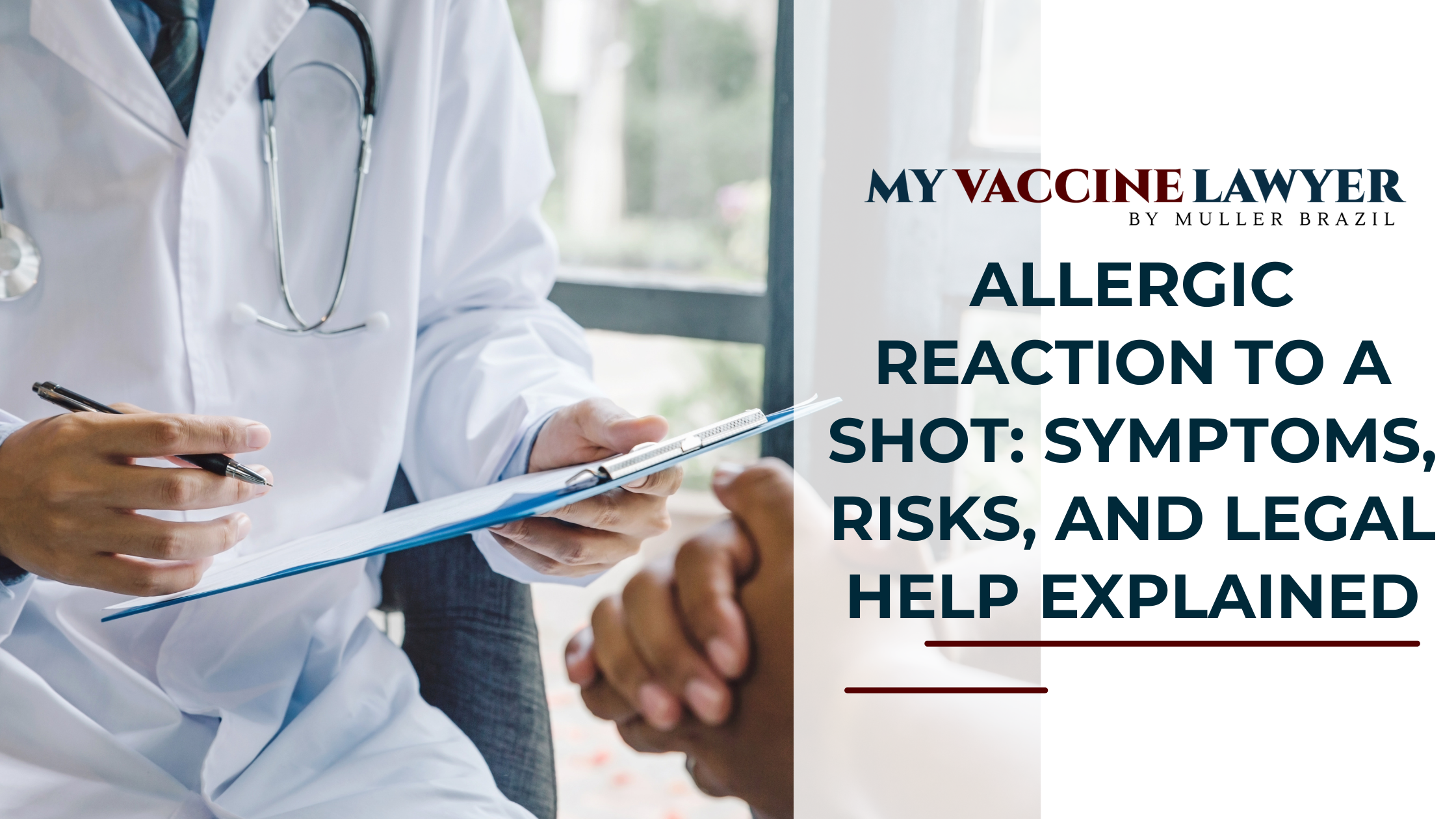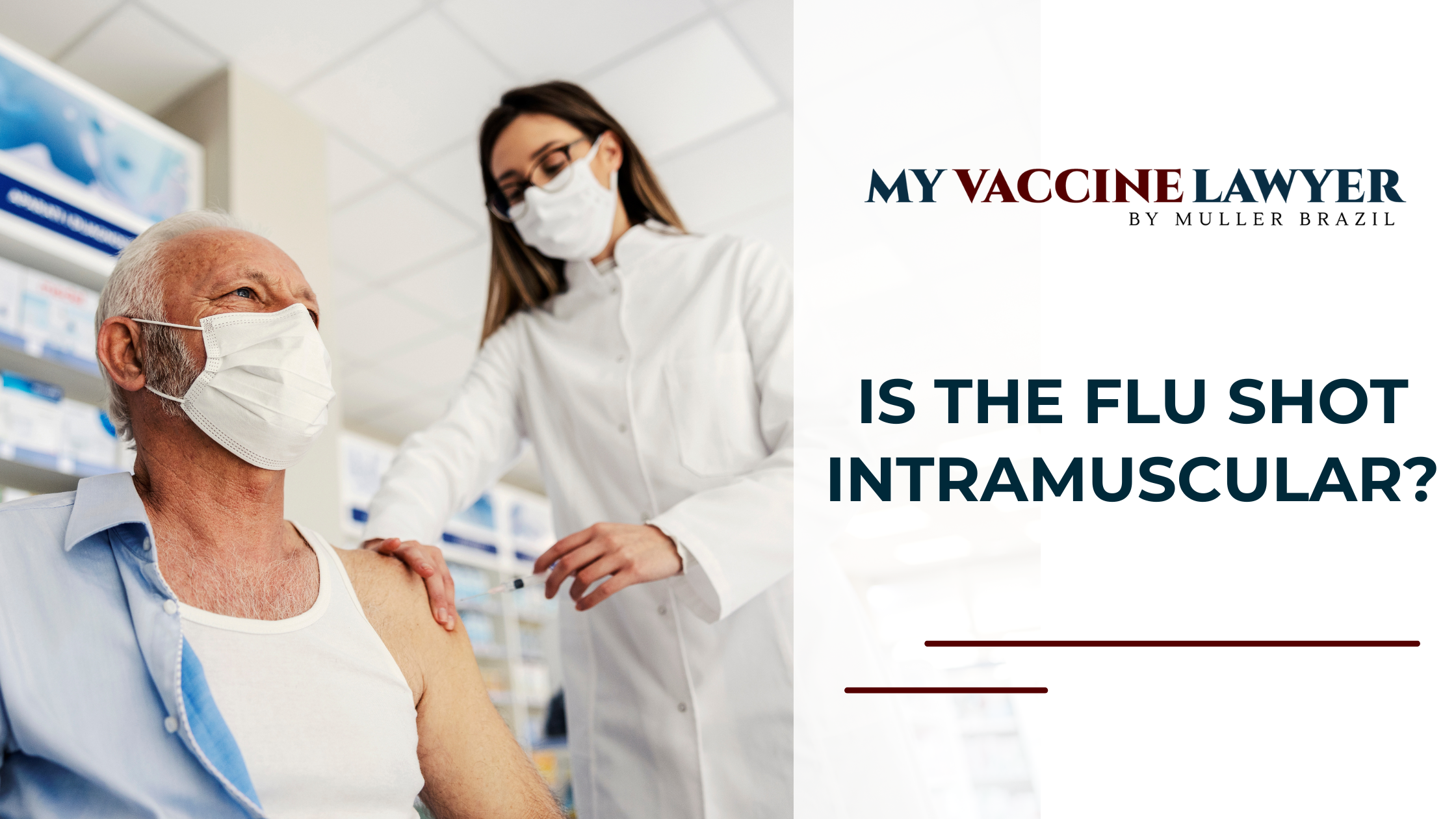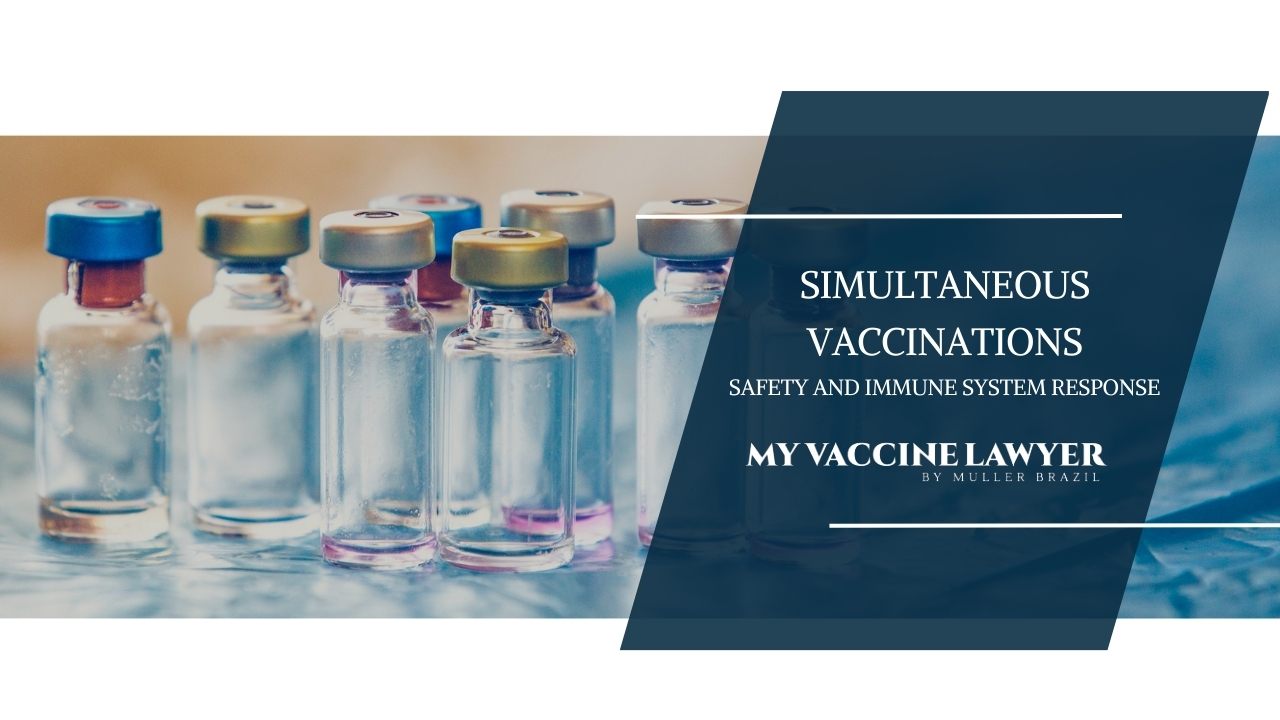Allergic Reaction to a Shot: Symptoms, Risks, and Legal Help Explained
Living with Chronic Inflammatory Demyelinating Polyneuropathy (CIDP), a rare autoimmune disorder, can be life-altering.
10 min read
Vaccine Injury Law Resources / Vaccines / Safe Multiple Vaccines: How Many Can You Get at Once?
 Max Muller
:
Jan 18, 2024 12:00:00 PM
Max Muller
:
Jan 18, 2024 12:00:00 PM
It's safe to get several vaccines at the same time, according to research and guidelines from the Centers for Disease Control and Prevention (CDC). Our immune system can handle multiple vaccines without any increased risk of long-term health problems. Vaccines go through strict testing to ensure they are safe before they are approved.
Health experts, including the CDC, recommend sticking to scheduled vaccination times, which often mean getting more than one vaccine during a single visit. This helps ensure protection against various diseases promptly.
Each shot in a vaccine schedule plays a vital role in protecting us from potentially deadly diseases. But what’s the science behind this?
The body’s defense force, our immune system, boasts impressive versatility. It identifies and responds to each vaccine administered, increasing its capacity to fight off disease-causing germs. Receiving multiple vaccines simultaneously improves our immune system’s response, making it even more efficient. The combined vaccines are just as effective as when administered individually. So, the question is not “how many vaccines,” but instead “how many diseases can we protect ourselves against?”
The recommended vaccination schedule, approved by expert groups such as the American Academy of Pediatrics, the CDC, and the American Academy of Family Physicians, is a product of extensive research. This schedule is designed to guarantee the most effective and safe protection against preventable diseases. Before receiving FDA approval, each vaccine endures rigorous testing to verify its safety and efficacy. Moreover, ongoing monitoring is conducted post-approval to make sure the immune system’s response to multiple immunizations is as expected.
The immune system is the body’s superhero, capable of producing specialized responses to a diverse range of antigens, including those introduced through vaccines. Research has indicated that vaccinated children exhibited fewer symptoms, such as:
and were less frequently hospitalized compared to their unvaccinated counterparts.
Conjugate vaccines, for instance, work by transforming a T cell-independent antigen into a T cell-dependent one. This process engages both B cells and helper T cells, generating high-affinity antibodies to the polysaccharide and forming long-term memory B cells. This mechanism is also applicable to influenza vaccines.
Equipped to handle multiple antigens, our immune systems are extremely competent. T and B cells respond to antigens from infections or vaccines, undergo multiplication, and differentiate to combat those specific threats. This intricate regulation within the immune response allows a coordinated and effective approach to vaccination and protection against vaccine-preventable diseases.
Combination vaccines combine two or more distinct vaccines into a single injection, functioning like a power-packed punch that protects against multiple diseases with a single shot. For instance, administering a varicella vaccine alongside other vaccines like DTP, Hib, or the hepatitis B vaccine does not increase the risk for breakthrough varicella.
However, a unique phenomenon known as the heterologous effect has been observed when the varicella vaccine is administered after, but within 30 days of MMR, which increases the risk for breakthrough varicella. This highlights the importance of spacing vaccines appropriately.
A study conducted by Shinefield et al. A study conducted in 1999 assessed the safety and immunogenicity of a heptavalent pneumococcal CRM197 conjugate vaccine administered simultaneously with DTwP, Hib, and OPV vaccines. The study concluded that this vaccine combination was found to be safe. Even though some adverse events were identified, none were related to the vaccine, reinforcing the safety profile of the combination.
Studies have shown that administering multiple vaccines in one visit neither reduces the immune response nor increases the risk of adverse reactions. In fact, it is typical to administer more than one shot during the same visit, often in separate limbs, for patient convenience.
Comprehensive guidance on vaccine administration techniques for various age groups is available in the ACIP “General Best Practices Guidelines for Immunization” on the CDC website and through Immunize.org handouts designed for children and adults.
For infants younger than 12 months, the thigh is the designated site for subcutaneous injections, whereas the upper-outer triceps area is used for individuals aged 12 months and older. The recommended needle length for subcutaneous injections is a 5/8-inch needle for all ages.
As diverse as the diseases they protect us from, the world of vaccines is quite varied. Here are some types of vaccines:
Each plays a unique role in bolstering our immunity against specific diseases.
But what is the mechanism through which these vaccines offer protection? Inactivated vaccines introduce inactivated pathogens into the body, triggering an immune response, whereas subunit vaccines consist of specific components of a pathogen, eliminating the need for the entire live pathogen to be present.
Our immune system, primed from birth to react to numerous environmental antigens, also responds to the specific antigens introduced through vaccines. So, rest assured, our bodies are well-prepared to handle the task.
Live vaccines use an attenuated version of the pathogen responsible for a particular disease. They can give long-lasting immunity with just one or two small doses. Live vaccines mimic an infection by using an attenuated version of the pathogen, preparing the immune system for a response. This results in beneficial non-specific effects, such as lower mortality rates.
Specific patient populations should avoid live vaccines because they carry a higher risk of adverse events, including potential vaccine-related infections. In rare instances, live vaccines lead to vaccine-associated paralytic poliomyelitis (VAPP), resulting in acute flaccid paralysis and residual effects. Furthermore, individuals with compromised immune systems are at risk of developing a mild form of the disease from the live vaccine.
Inactivated vaccines are formulated using the deactivated form of the disease-causing microorganism. This deactivation process typically involves heat, radiation, or chemicals that render the pathogen incapable of reproducing, thus triggering an immune response without the risk of causing the disease. On the other hand, subunit vaccines consist of the essential antigenic elements of the pathogen required to stimulate an immune response, excluding the components that could potentially induce the disease.
Various diseases such as polio, hepatitis A, and rabies, among others, are often prevented using inactivated and subunit vaccines, including the inactivated polio vaccine. They play an important role in preventing these illnesses.
While inactivated vaccines offer stability for easier storage, transportation, and safety for individuals with weakened immune systems, they generally produce a weaker immune response than live vaccines, often requiring multiple doses for sustained immunity.
The notion of immune overload is one of the common misconceptions associated with vaccinations. The belief is that administering multiple vaccines simultaneously may overburden a child’s immune system. However, numerous studies have refuted this concept, demonstrating that vaccinated children are less likely to fall ill than unvaccinated children.
Interestingly, among the numerous studies conducted, none have found a correlation between multiple immunizations and the overall occurrence of type 1 diabetes or other autoimmune disorders. This suggests that our immune system is not easily overburdened. Rather, it is capable and adaptable, ready to respond to the antigens introduced through vaccines.
Indeed, without becoming overwhelmed, the infant immune system capably manages the antigens introduced during routine immunization. So, the next time you’re at the doctor’s office pondering how many vaccines can be administered without risk, remember, that the immune system is more resilient than you think!
The myth of immune overload implies that a child’s immune system may be overburdened by administering multiple vaccines at once. This myth, however, has been debunked by numerous studies. Research has demonstrated that vaccinated children are less likely to fall ill than unvaccinated children.
In fact, multiple vaccinations do not overwhelm or weaken the immune system. Instead, they make the immune system stronger by protecting against diseases. The majority of individuals can receive multiple routine vaccines simultaneously without overburdening the immune system. Research has shown that the recommended vaccines are equally effective when administered together as they are individually.
Common side effects are typically mild and may include soreness, redness, or swelling at the injection site. More significant side effects, such as fever and febrile seizures, are temporary and do not result in lasting harm.
The marked decrease in morbidity, mortality, and disability underscores the effectiveness of childhood vaccines in battling a vaccine-preventable disease and contributing to disease control. In simple terms, vaccines have greatly reduced diseases and deaths. Specifically, there has been over a 92% drop in cases and more than a 99% decrease in deaths from diseases that can be prevented by vaccines recommended before 1980.
Moreover, childhood vaccination has averted 33,000 fatalities and 14 million instances of disease, while vaccines have prevented nearly 20 million cases of diseases for a single birth cohort.
Vaccines are effective in preventing a wide range of diseases that have historically caused significant health issues. These include:
Following vaccine schedules offers significant epidemiological advantages, including:
This is a testament to vaccines' power and ability to keep vaccine-preventable diseases at bay.
Vaccination should cater to an individual’s needs. Certain populations, such as pregnant women and individuals with allergies, have specific vaccination considerations.
Pregnant women, for example, are encouraged to contemplate vaccines such as whooping cough and flu, which are generally deemed safe. It is generally not recommended for pregnant women to receive vaccines that contain a live attenuated virus.
Likewise, even individuals with severe egg allergies are able to receive the influenza vaccine. The vaccine contains minimal egg protein and does not pose an increased risk of reaction.
Pregnant women are advised to consider the following vaccines, as they have been deemed safe:
Notably, the pneumococcal polysaccharide vaccine has been shown to be safe when administered during the second and third trimesters.
Vaccines that are recommended for use during pregnancy produce a vaccine-specific immune response in the mother, resulting in the production of antibodies. These antibodies are then passed on to the fetus through the placenta, offering protection against infections.
Certain vaccines are considered safe for administration throughout pregnancy, with pneumococcal vaccines being specifically recommended for the second and third trimesters. However, there are potential risks of vaccinating pregnant women, including theoretical risks such as fetal infection from certain vaccines like the anthrax vaccine adsorbed. Furthermore, contracting diseases in early pregnancy, such as:
can result in miscarriage or significant birth defects.
When it comes to allergies, the best practice is prevention. Identifying individuals at increased risk through a history of allergy to previous vaccinations helps healthcare providers to take precautionary measures. Individuals with egg allergy may receive any vaccine (egg-based or non-egg-based) that is otherwise appropriate for their age and health status.
In some cases, alternative vaccines may be available that do not contain specific allergenic components and allergen immunotherapy can be considered a form of therapeutic vaccination to modify vaccines for individuals with allergies.
Allergic reactions to vaccine components are infrequent, with an estimated incidence of 1 reaction per 1 million injections for most known vaccines. Typical allergens found in vaccines include:
One of the most important decisions when it comes to vaccines involves assessing the risks against the benefits of multiple vaccinations. Regardless of the number of vaccines administered, the most important thing is that they are effective and safe.
Most side effects from vaccinations, including soreness, redness or swelling at the injection site, or a mild fever and fatigue, are mild and transient. Serious side effects are exceptionally rare.
The risk-benefit ratio for administering multiple vaccines in one visit is evaluated by meticulously weighing the benefits of immunity against the potential risks of side effects for each vaccine. Prior to approval for use, vaccines undergo thorough assessments of safety, efficacy, and quality.
Take Control of Your Injury Today
Common adverse reactions to vaccinations include:
Serious side effects from vaccines are uncommon, with most people experiencing only mild and temporary side effects that resolve on their own.
The severity of side effects from multiple vaccinations can vary, including:
That said, there may be an increase in side effects when multiple vaccines are administered simultaneously.
As they increase the potential for individuals to acquire diseases and heighten the risk of community transmission, delayed vaccination schedules can present significant public health risks. It’s important to note that no scientific evidence demonstrates the benefits of delaying vaccines.
Indeed, there have been documented cases where delaying or spacing out vaccines has resulted in adverse outcomes. This can lead to prolonged susceptibility to diseases and may cause delayed protection and severe health risks by not following the recommended schedule.
Vaccination doesn’t follow a one-size-fits-all approach. Our individual lifestyles, travel plans, and occupational risks require personalized vaccination plans. A customized vaccination plan for travelers takes into account numerous factors, such as:
Just like travelers, healthcare workers also face unique risks and exposures requiring personalized vaccination schedules. This provides targeted protection against occupational hazards and helps in preventing the spread of contagious diseases within these settings.
The CDC website provides essential information on vaccines recommended for foreign travel. Depending on the destinations, U.S. citizens traveling internationally may be required to receive commonly recommended vaccines like:
in addition to other vaccines such as:
Travelers intending to visit sub-Saharan Africa and tropical South America must make sure they have received a yellow fever vaccination as it is a requirement.
However, it is not possible to administer all travel vaccines at the same time. For example, if a traveler needs vaccines for cholera and typhoid fever, the cholera vaccine must be administered first, followed by the typhoid vaccine at least eight hours later.
It’s advised that healthcare workers maintain their routine vaccines, which include the chickenpox and annual flu vaccines, as per their age requirements. Additionally, they should have documentation of 2 doses of MMR vaccine or proof of immunity to measles, mumps, and rubella.
Tailoring vaccination schedules based on occupation is vital as it allows for addressing the specific risks and exposures found in different work environments. This provides targeted protection against occupational hazards and helps prevent the spread of contagious diseases within those settings.
If a healthcare worker cannot receive vaccines due to allergies or other health issues, vaccination should be deferred for those with a moderate or severe acute illness. Specific guidelines exist to triage these situations, such as the CDC’s guidance on managing people with allergies to vaccine components.
This guide aims to help you fully understand vaccines, the science behind their administration, and the importance of following the recommended schedules. We’ve debunked the myth of immune overload, explored the different types of vaccines, and looked into the implications of delaying vaccinations.
Armed with this knowledge, we hope you feel empowered to make informed decisions about vaccinations, keeping in mind that the ultimate goal is to stay healthy and protect those around us.
Yes, you can get 3 vaccines at once, as receiving the flu, COVID-19, and RSV vaccines may be possible during a single appointment, making it more convenient to stay up to date with immunizations.
There is no maximum limit to the number of vaccines that can be given at one time. In certain medical situations, multiple vaccines may need to be administered simultaneously.
Yes, you can get two vaccines in the same arm, as long as they are administered at least 1 inch apart, to avoid discomfort and ensure proper absorption. Avoid getting them in the same area to prevent irritation.
Yes, some vaccines like whooping cough and flu are safe for pregnant women, but vaccines with a live attenuated virus are generally not recommended. It's important to consult with a healthcare professional about vaccination during pregnancy.
Yes, individuals with severe egg allergies can receive the influenza vaccine, regardless of whether it is egg-based or non-egg-based.
Mr. Muller currently devotes the majority of his law practice to aggressively fighting for the victims of unsafe drug and medical device injuries, as well as vaccine injuries and vaccine reactions involving the flu shot, TDaP/DTaP vaccine, and more. He has handled hundreds of SIRVA injury cases (shoulder injury related to vaccine administration), especially those involving bursitis, tendonitis, frozen shoulder, and rotator cuff tears. Mr. Muller also handles cases where vaccines caused serious nerve injuries such as Guillain-Barre Syndrome. Mr. Muller has recovered millions of dollars in compensation for his clients in the Vaccine Injury Compensation Program.

Living with Chronic Inflammatory Demyelinating Polyneuropathy (CIDP), a rare autoimmune disorder, can be life-altering.

Vaccines play an important role in protecting older adults, especially those who are homebound and face specific challenges in accessing healthcare...

Yes, the flu shot is administered intramuscularly in most cases, typically in the deltoid muscle of the upper arm.
